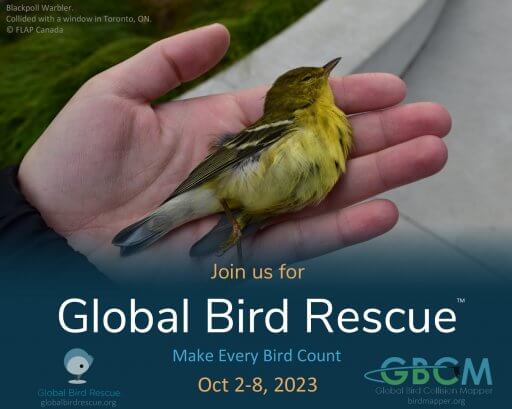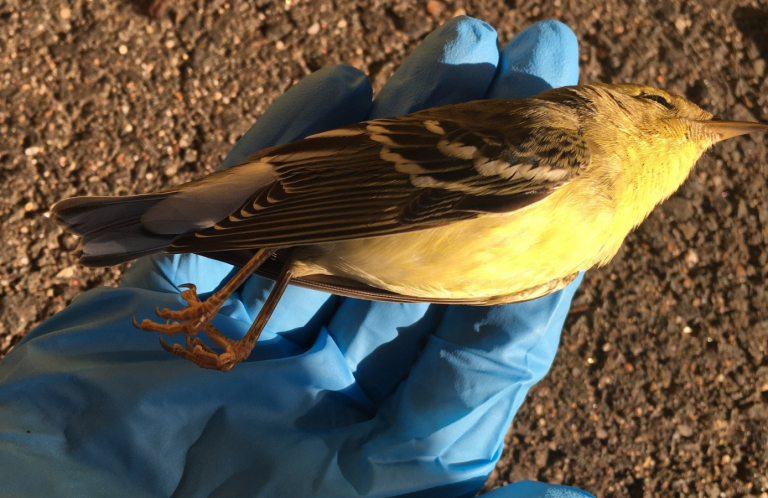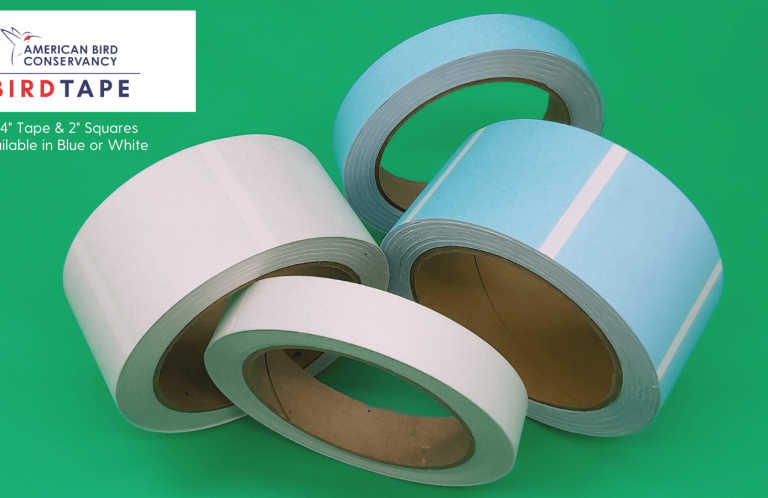Making Buildings Better during Global Bird Rescue Week

Today marks the beginning of Global Bird Rescue Week. Running through October 8th, American Bird Conservancy (ABC) invites everyone to join ABC, FLAP Canada, and countless other bird conservation groups and members of the public around the world to rescue and document wild birds that have collided with buildings during their fall migration.
Each year during the peak of fall migration in North America, billions of birds navigate man-made environments as they fly south for winter to warmer environments with more food sources. Unfortunately, millions will not reach their final destinations due to a fatal collision with a building.
Fall migration has more building collisions than spring migration for several reasons. Given that most birds have finished breeding, a higher number of birds migrate in the fall. This journey includes both adults and juveniles, whereas during spring migration only breeding adults make the trip.
Most birds migrate at night, such as the Indigo Bunting, using the stars to navigate for thousands of miles in a small number of days. Light pollution at night and reflective glass surfaces during the day disorient them. Juvenile birds are less experienced travelers and tend to suffer more challenges, especially in urban areas. When birds see plants or the sky reflected in windows, they do not know there is a barrier and think they can fly through it, then they collide with the glass.
Most people may assume birds can cope and fly away right after a collision. However, birds often end up sustaining unseen serious injuries such as bruising, eye ulcers, and fractures that prevent them from continuing their journeys. The good news is, people can help. Given the loss of nearly 3 billion birds in the U.S. and Canada since 1970, ABC is encouraging the following solutions to help birds survive and thrive.
Preventing Bird Collisions at Home
If a bird has collided with your home, you are not alone! Up to 1 billion birds die each year following window collisions in the United States. The good news is that there are easy solutions that can help. Learn more »
For example, there are many ways to make your own windows bird-friendly. One of the easiest is to use external insect screens. If screens aren't an option, you can use a range of materials — tape, decals, strings, cords, and paint are options — to create window patterns that birds will interpret as solid objects to be avoided. Netting and shutters can also be helpful.
Learn more about these home-friendly solutions, and for information about additional effective products that prevent collisions, visit ABC's Glass Collisions Products and Solutions Database.
How to Design and Legislate Bird-Friendly Buildings
Glass collisions from taller buildings kill vast numbers of wild birds each year. Yet most people know little about this danger, and even fewer are aware of the solutions available to help prevent these deaths — ones that are easy, attractive, and inexpensive. Whether you want to reduce bird collisions at an existing building, design a new bird-friendly structure, or promote bird-safe building legislation, ABC has top-rated resources available for professionals in facility construction, renovations, operations, maintenance, and real estate development.
For a more in-depth look about bird-safe building legislation solutions, read ABC and the Yale University Law, Ethics and Animals Program's newest report here.
Common Species that Collide with Windows
Researchers working in several U.S. and Canadian cities actively monitor bird-window collisions, gathering information on frequent-collider species each year. Certain migratory birds, such as the Black-and-white Warbler, Dark-eyed Junco, and White-throated Sparrow appear to be particularly vulnerable to this threat. For a list of species most likely to die from window collisions, learn more here.
What to Do with an Injured Bird
Some common but subtle signs that indicate a bird is injured and in need of medical treatment by a licensed wildlife rehabilitator include the following:
- Allows you to pick it up.
- Cannot stand.
- Is not using both feet.
- Is squinting or shutting its eyes.
- Has open-mouthed or heavy breathing.
- Has puffed up feathers or tucks its head under its wings.
Contact your local wildlife rehab center or visit flap.org for advice on how to further help.
Glass collisions take a staggering toll on birds every year, threatening common and rare species alike. Solving a problem of this size requires big thinking, bold ideas, and collective action. To participate in Global Bird Rescue Week, visit globalbirdrescue.org.
###
American Bird Conservancy is a nonprofit organization dedicated to conserving wild birds and their habitats throughout the Americas. With an emphasis on achieving results and working in partnership, we take on the greatest problems facing birds today, innovating and building on rapid advancements in science to halt extinctions, protect habitats, eliminate threats, and build capacity for bird conservation. Find us on abcbirds.org, Facebook, Instagram, and Twitter (@ABCbirds).
Media Contact
Jordan Rutter
Director of Communications
media@abcbirds.org


















































